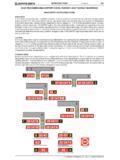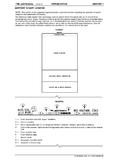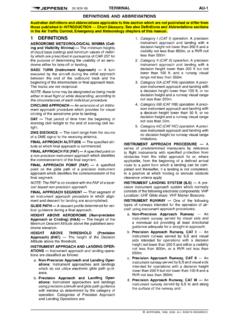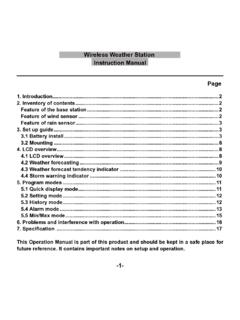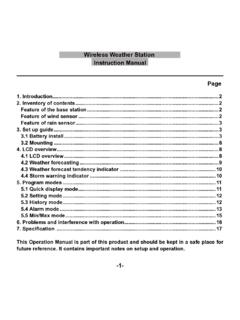Transcription of ABBREVIATIONS USED IN AIRWAY MANUAL DEFINITIONS
1 19 MAR 10 INTRODUCTION 41. ABBREVIATIONS USED IN AIRWAY MANUAL . DEFINITIONS AIREP Air-Report AIS Aeronautical Information Services A/A Air to Air ALA Aircraft Landing Area AAF Army Air Field ALF Auxiliary Landing Field AAIM Aircraft Autonomous Integrity ALS Approach Light System Monitoring ALS Low Intensity Approach Lights AAIS Automated Aerodrome Information ALT Altitude Service ALTN Alternate AAL Above Aerodrome Level AMA Area Minimum Altitude AAS Airport Advisory Service AMSL Above Mean Sea Level AAU Authorized Approach UNICOM. ANGB Air National Guard Base AB Air Base AOE Airport/Aerodrome of Entry ABM Abeam ABN Aerodrome Beacon AOM Airport Operating Minimums AOR Area of Responsibility AC Air Carrier APAPI Abbreviated Precision Approach ACA Arctic Control Area Path Indicator ACA Approach Control Area APC Area Positive Control ACAS Airborne Collision Avoidance APCH Approach System APP Approach Control ACARS Airborne Communications Addressing and Reporting System APT Airport ACC Area Control Center APV Approach Procedure with Vertical Guidance ACFT Aircraft AR Authorization Required ACN Aircraft Classification Number ARB Air Reserve Base AD Aerodrome ARINC Aeronautical radio , Inc.
2 ADA Advisory Area ARO Aerodrome Reporting Officer ADF Automatic Direction Finding ARP Airport Reference Point ADIZ Air Defense Identification Zone ARR Arrival ADNL Additional ARTCC Air Route Traffic Control Center ADR Advisory Route ASDA Accelerate Stop Distance Available ADS Automatic Dependent Surveillance ADV Advisory Area ASOS Automated Surface Observing System AEIS Aeronautical Enroute Information Service ASR Airport Surveillance Radar AER Approach End of Runway ATA Actual Time of Arrival AERADIO Air radio ATCAA Air Traffic Control Assigned Airspace AERO Aerodrome ATCC Air Traffic Control Center AF Aux Air Force Auxiliary Field ATCT Air Traffic Control Tower AFB Air Force Base ATD Actual Time of Departure AFIS Aerodrome Flight Information Service ATF Aerodrome Traffic Frequency AFLD Airfield ATFM Air Traffic Flow Management AFN American Forces Network ATIS Automatic Terminal Information Service AFRS Armed Forces radio Stations ATND SKD Attended Scheduled Hours AFRU Aerodrome Frequency Response Unit ATS Air Traffic Service AFS Air Force station ATZ Aerodrome Traffic Zone AFSS Automated Flight Service station AU Approach UNICOM.
3 A/G Air-to-Ground AUP Airspace Utilization Plane AGL Above Ground Level AUTH Authorized AGNIS Azimuth Guidance Nose-in-Stand AUW All-up Weight AH Alert Height AUX Auxiliary AVBL Available AHP Army Heliport AWIB Aerodrome weather Information AIRAC Aeronautical Information Broadcast Regulation and Control q$z JEPPESEN, 1984, 2010. ALL RIGHTS RESERVED. 42 INTRODUCTION 19 MAR 10. ABBREVIATIONS USED IN AIRWAY MANUAL . AWIS Aerodrome weather Information CONTD Continued Service COORDS Coordinates AWOS Automated weather Observing COP Change Over Point System CORR Corridor AWSS Aviation weather Sensor System CP Command Post AWY AIRWAY CPDLC Controller Pilot Data Link AZM Azimuth Communications Baro VNAV Barometric Vertical Navigation Cpt Clearance (Pre-Taxi Procedure).
4 BC Back Course CRC Cyclical Redundancy Check BCM Back Course Marker CRP Compulsory Reporting Point BCN Beacon CRS Course BCOB Broken Clouds or Better CST Central Standard Time BCST Broadcast CTA Control Area BDRY Boundary CTAF Common Traffic Advisory BLDG Building Frequency BM Back Marker CTL Control BRG Bearing CTOT Calculated Take-off Time B-RNAV Basic RNAV CTR Control Zone BS Broadcast station (Commercial) CVFP Charted Visual Flight Procedure C ATC IFR Flight Plan Clearance CVFR controlled VFR. Delivery Frequency D Day CADIZ Canadian Air Defense Identification DA Decision Altitude Zone DA (H) Decision Altitude (Height). CAE Control Area Extension D-ATIS Digital ATIS. CA/GRS Certified Air/Ground radio Service DCL Data Link Departure Clearance CANPA Constant Angle Non-Precision Service Approach DCT Direct CARS Community Aerodrome radio station DECMSND Decommissioned CAT Category DEG Degree CBA Cross Border Area DEP Departure Control/Departure Procedures CDFA Continuous Descent Final Approach DER Departure End of Runway CDI Course Deviation Indicator DEWIZ Distance Early Warning Identification Zone CDR Conditional Route DF Direction Finder CDT Central Daylight Time DISPL Displaced Threshold CEIL Ceiling THRESH.
5 CERAP Combined Center/Radar Approach DIST Distance Control DME Distance-Measuring Equipment CFIT controlled Flight Into Terrain DOD Department of Defense CGAS Coast Guard Air station DOM Domestic CGL Circling Guidance Lights DP Obstacle Departure Procedure CH Channel DRCO Dial-up Remote Communications CH Critical Height Outlet CHGD Changed E East or Eastern CL Centerline Lights EAT Expected Approach Time CMNPS Canadian Minimum Navigation ECOMS Jeppesen Explanation of Common Performance Specification Minimum Specifications CMV Converted Met Visibility EDT Eastern Daylight Time CNF Computer Navigation Fix EET Estimated Elapsed Time CO County EFAS Enroute Flight Advisory Service COMLO Compass Locator EFF Effective COMMS Communications EFVS Enhanced Flight Vision System CONT Continuous q$z JEPPESEN, 1984, 2010.
6 ALL RIGHTS RESERVED. 19 MAR 10 INTRODUCTION 43. ABBREVIATIONS USED IN AIRWAY MANUAL . EH Eastern Hemisphere GLONASS Global Orbiting Navigation Satellite ELEV Elevation System EMAS Engineered Materials Arresting GLS Global Navigation Satellite System System [GNSS] Landing System EMERG Emergency GMT Greenwich Mean Time ENG Engine GND Ground Control EOBT Estimated Off Block Time GND Surface of the Earth (either land or water). EST Eastern Standard Time GNSS Global Navigation Satellite System EST Estimated GP Glidepath ETA Estimated Time of Arrival GPA Glidepath Angle ETD Estimated Time of Departure GPS Global Positioning System ETE Estimated Time Enroute GPWS Ground Proximity Warning System ETOPS Extended Range Operation with two-engine airplanes GS Glide Slope EVS Enhanced Vision System G/S Ground Speed FAA Federal Aviation Administration GWT Gross Weight FACF Final Approach Course Fix H Non-Directional radio Beacon or High Altitude FAF Final Approach Fix H24 24 Hour Service FAIL Failure HAA Height Above Airport FANS Future Air Navigation System FAP Final Approach Point HALS High Approach Landing System FAR Federal Aviation Regulation HAS
7 Height Above Site FAS DB Final Approach Segment Datablock HAT Height Above Touchdown FAT Final Approach Track HC Critical Height FATO Final Approach and Take-off Area HDG Heading FCP Final Control Point HF High Frequency (3-30 MHz). FIA Flight Information Area HGS Head-up Guidance System FIC Flight Information Center HI High (altitude). FIR HI High Intensity (lights). Flight Information Region FIS Flight Information Service HIALS High Intensity Approach Light System FL Flight Level (Altitude). HIRL High Intensity Runway Edge Lights FLARES Flare Pots or Goosenecks HIRO High Intensity Runway Operations FLD Field HIWAS Hazardous Inflight weather FLG Flashing Advisory Service FLT Flight HJ Sunrise to Sunset FM Fan Marker HN Sunset to Sunrise FMC Flight Management Computer HO By Operational Requirements FMS Flight Management System hPa Hectopascal (one hectopascal =.)
8 FPM Feet Per Minute one millibar). FPR Flight Planning Requirements HR Hours (period of time). FRA Free Route Airspace HS During Hours of Scheduled FREQ Frequency Operations FSS Flight Service station HST High Speed Taxiway Turn-off FT Feet HUD Head-up Display FTS Flexible Track System HUDLS Head-Up Display Landing System G Guards only ( radio frequencies) HX No Specific Working Hours GA General Aviation Hz Hertz (cycles per second). GBAS Ground-Based Augmentation I Island System IAC Instrument Approach Chart GCA Ground controlled Approach IAF Initial Approach Fix (radar) IAML Integrity Monitor Alarm GCO Ground Communication Outlet IAP Instrument Approach Procedure GEN General IAS Indicated Airspeed q$z JEPPESEN, 1984, 2010.
9 ALL RIGHTS RESERVED. 44 INTRODUCTION 19 MAR 10. ABBREVIATIONS USED IN AIRWAY MANUAL . IATA International Air Transport Lctr Locator (Compass). Association LDA Landing Distance Available IAWP Initial Approach Waypoint LDA Localizer-type Directional Aid IBN Identification Beacon LDI Landing Direction Indicator ICAO International Civil Aviation LDIN Lead-in Light System Organization LGTH Length IDENT Identification LIM Locator Inner Marker IF Intermediate Fix LIRL Low Intensity Runway Lights IFBP Inflight Broadcast Procedure LLWAS Low Level Wind Shear Alert IFR Instrument Flight Rules System IGS Instrument Guidance System LMM Locator Middle Marker ILS Instrument Landing System LNAV Lateral Navigation IM Inner Marker LNDG Landing IMAL Integrity Monitor Alarm LO Locator at Outer Marker Site IMC Instrument Meteorological LOC Localizer Conditions LOM Locator Outer
10 Marker IMTA Intensive Military Training Area LONG Longitude INDEFLY Indefinitely LPV Localizer Performance with Vertical IN or INS Inches Guidance INFO Information LSALT Lowest Safe Altitude INOP Inoperative LT Local Time INS Inertial Navigation System LTP Landing Threshold Point INT Intersection LTS Lights INTL International LVP Low Visibility Procedures IORRA Indian Ocean Random RNAV Area LWIS Limited weather Information IR Instrument Restricted controlled System Airspace M Meters IS Islands MAA Maximum Authorized Altitude ITWS Integrated Terminal weather MAG Magnetic System MAHF Missed Approach Holding Fix I/V Instrument/Visual controlled MALS Medium Intensity Approach Light Airspace System JAA Joint Aviation Authorities MALSF Medium Intensity Approach Light JAR-OPS Joint Aviation Requirements Oper- System with Sequenced Flashing ations Lights KGS Kilograms MALSR Medium Intensity Approach Light kHz Kilohertz System with Runway Alignment KIAS Knots Indicated Airspeed Indicator Lights KM Kilometers MAP Missed Approach Point KMH Kilometer(s) per Hour MAX Maximum KT Knots MB Millibars KTAS Knots True Airspeed MCA Minimum Crossing Altitude L Locator (Compass) MCAF Marine Corps Air Facility LAA Local Airport Advisory MCAS Marine Corps Air station LAAS Local Area Augmentation System MCTA Military controlled Airspace LACFT Large Aircraft MDA Minimum Descent Altitude LAHSO Land and Hold Short Operations MDA(H)
